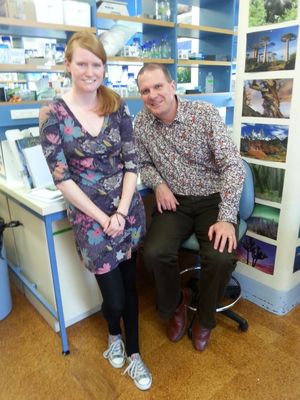“Bones which are regularly loaded and exercised get stronger, and bones which aren’t exercised – maybe if you’re on bed rest or in a wheelchair or an astronaut in space -- get weaker,” says University of Otago PhD student Emma Wade.
 While this phenomenon is well known, the molecular mechanisms of how the force of gravity, is sensed in bone is not known, and this is something that Emma (pictured left) and her supervisor Professor Stephen Robertson (pictured right) are looking into.
While this phenomenon is well known, the molecular mechanisms of how the force of gravity, is sensed in bone is not known, and this is something that Emma (pictured left) and her supervisor Professor Stephen Robertson (pictured right) are looking into.
“We think filamin is part of this, we think it not only protects your cells from the day to day movement that your skeleton does, but also somehow signals to the cell that that movement is happening and tells it to turn on pathways to make more bone,” says Emma.
Filamin A is a protein with a hinge that allows it to flex and bend. It's basically a cellular spring. Emma is looking at patients with a condition called frontometaphyseal dysplasia who have very dense bones, implying that the force sensing mechanism in their bones has gone wrong. These patients have mutations in the gene that encodes for filamin A.
Emma is looking at the skin cells of patients with this condition, as well a mouse model, to try and determine how the force-sensing mechanism works. This would not only help patients and their families, understand how the condition works, but in the future may lead to some form of therapy for people who are bed-ridden, or wheelchair bound, or astronauts in space.
“Plus, finding filamin A’s role in the skeleton is really useful for downstream therapies skeletal conditions like osteoporosis which are big conditions affecting the whole world really,” says Emma.

